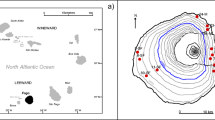Abstract
The article describes the use of Scots pine bark to identifynitrogen sources in eastern Germany, as well as background areas in Russia and Bulgaria, by using natural isotope ratios of total nitrogen (Nt) and individual N compoundssuch as ammonium (NH4 +), nitrate (NO3 -)and amid nitrogen (amide-N). The samples collected were analysed using an elemental analyser in connection with a gas isotope mass spectrometer (EA-IRMS). Natural 15N abundances in pine bark from impact areas suggest that the ammonium accumulated on the surface of the bark is releasedfrom livestock management. Bark of Scots pines growing near agricultural land had highly depleted δ15Nt values (between –8 and –12‰), while bark from background areas (unpolluted areas) displayed slightly negative δ15Nt values (mean 15Nt = –3.8‰). It is assumed that part of the N adsorbed on the bark surface is mainly derived from ammonia(mean 15Nt = –40.3‰) escaping from livestock housing and during the application of manure. This assumption is confirmed by experiments under controlled conditions in which manure samples were spread on soil. In addition, temporal and spatial variations of 15Nt abundances in pine bark from various locations in eastern Germany as wellas pine stands in Nature Park Dübener Heath are discussed.
Similar content being viewed by others
References
Aber, J. D., Nadelhoffer, K. J., Steudler, P.A. and Melillo, J.M.: 1989, Nitrogen saturation in northern forest ecosystems, BioScience 39, 378–386.
Andersen, H. V. and Hovmand, M. F.: 1999, Review of dry deposition measurements of ammonia and nitric acid to forest. Forest ecology and management. 114, 5–18.
Apsimon, H. M., Kruse, M. and Bell, J. N. B.: 1987, Ammonia emissions and their role in acid deposition. Atmos. Environ. 22, 1939–1946.
Asman, W. A. H., Sutton, M. A. and Schørring, J. K.: 1998, Ammonia: Emission, atmospheric transport and deposition. New Phytol. 139, 27–48.
Erskine, P. D., Bergstrom, D. M., Schmidt, S., Stewart, G. R., Tweedie, C. E. and Shaw, J. D.: 1998, Subantarctic Macqarie Island – A model ecosystem for studying animal-derived sources using 15N natural abundances. Oecologia 117, 187–193.
Fangmeier, A., Hadwiger-Fangmeier A., Van der Eerden, L. J. M. and Jäger, H.-J.: 1994, Effects of atmospheric ammonia on vegetation-A review. Environ. Pollut. 86, 43–82.
Gehre, M.: 1994, Methodische Untersuchungen zum 15N-ConFlo-IRMS-System. Isotopenpraxis. Environ. Health Stud. 30, 239–245.
Heaton, T. H. E.: 1988, Isotopic studies of nitrogen pollution in the hydrosphere and atmosphere: A review. Chem. Geol. 59, 87–102.
Huhn, G., Schulz, G., Stärk, H.-J., Tölle, R. and Schüürmann, G.: 1995, Evaluation of regional heavy metal deposition by multivariate analysis of element contents in pine bark. Water, Air, and Soil Pollut. 84, 367–383.
Jung, K., Gebauer, G., Gehre, M., Hofmann, D., Weißflog, L. and Schüürmann, G.: 1997, Anthropogenic impacts on natural nitrogen isotope variations in Pinus sylvestris stands in an industrially polluted area. Environmental Pollution 97, 175–181.
Loppi, S., Nelli, L., Ancora, S. and Bargagli, R.: 1997, Passive monitoring of trace elements by means of tree leaves, epiphytic lichens and barks substrate. Environmental Monitoring and Assessment 45, 81–88.
Moore, H.: 1977, The isotopic composition of ammonia, nitrogen dioxide and nitrate in the atmosphere. Atmospheric Environment 11, 1239–1243.
Poikolainen, J.: 1997, Sulphur and heavy metal concentrations in Scots pine bark in northern Finland and the Kola peninsula. Water, Air, and Soil Pollut. 93, 395–408.
Raunemaa, T., Hari, P., Kukkonen, J., Kulmala, M. and Karhula, M.: 1987, Analysis of the bark of scots pine as a method of studying environmental changes. Water, Air, and Soil Pollut. 32, 445–453.
Schulz, H., Huhn, G., Niehus, B., Liebergeld, G. and Schüürmann, G.: 1997, Determination of throughfall rates on the basis of pine bark loads: Results of a field study. Air and Waste Manage. Association. 47, 510–516.
Schulz, H., Popp, P., Huhn, G., Stärk, H.-J. and Schüürmann, G.: 1999a, Biomonitoring of airborne inorganic and organic pollutants by means of pine tree barks. I. Temporal and spatial variations. The Science of the Total Environment 232, 49–58.
Schulz, H., Härtling, S., Huhn, G. and Schüürmann, G.: 1999b, 'Nachweis ökotoxikologischer Wirkungen in Kiefernökosystemen-Ergebnisse einer langfristig angelegten Freilandstudie', in Oehlmann, Markert (ed.), Ökotoxikologie-Ökosystemare Ansätze und Methoden, Ecomed Verlagsgesellschaft, pp. 248–267.
Stöcker, G.: 1993, Elementgehalte von Kiefern-und Fichtenborke – Indikation der Immissionsbelastung von Nadelwald-Ökosystemen. Arch. für Nat.-Lands. 32, 183–207.
Stöcker, G.: 1971, Die Bestimmung von Ammonium-, Nitrit-und Nitrat-Stickstoff mit einer Mikrodestillationsmethode bei ökologischen Untersuchungen. Arch. Naturschutz u. Landschaftsforsch. 11, 183–192.
United Kingdom Review Group on Impacts of Atmospheric Nitrogen: 1994, 'Impacts of Nitrogen Depositions on Terrestrial Ecosystems', Pitcairn, C. E. R. (ed.) Report of U.K. Review Group on Impact of Atmospheric N. London, U.K. Department of the Environment.
Author information
Authors and Affiliations
Corresponding author
Rights and permissions
About this article
Cite this article
Schulz, H., Gehre, M., Hofmann, D. et al. Nitrogen Isotope Ratios in Pine Bark as an Indicator of N Emissions from Anthropogenic Sources. Environ Monit Assess 69, 283–297 (2001). https://doi.org/10.1023/A:1010705907525
Issue Date:
DOI: https://doi.org/10.1023/A:1010705907525




